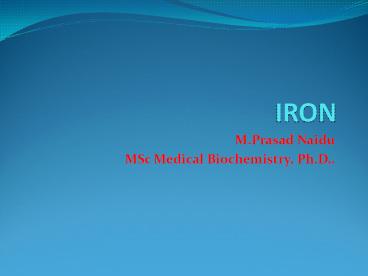IRON - PowerPoint PPT Presentation
Title:
IRON
Description:
BIOCHEMISTRY – PowerPoint PPT presentation
Number of Views:2357
Title: IRON
1
IRON
- M.Prasad Naidu
- MSc Medical Biochemistry, Ph.D,.
2
Iron (Fe)
- 2 types of body iron
- heme iron
- hemoglobin, myoglobin, catalases, peroxidases,
cytochromes (a, b and c involved in electron
transport), cytochrome P450 (involved in drug
metabolism) - non-heme iron
- ferritin, hemosiderin, hemofuscin, transferrin,
ferroflavoproteins, aromatic amino acid
hydroxylases - food iron is also classified as heme and non-heme
3
Food iron
- heme iron
- meats
- poultry
- fish
- 20-23 of heme-iron is absorbable
- non-heme iron
- vegetables
- fruits
- legumes
- nuts
- breads and cereals
- only 3 on non heme iron is absorbed
4
Iron absorption
- occurs in upper part of small intestine
- about 10 of food iron is absorbed
- requires gastric HCl (releases ionic iron)
- also requires copper
- ferrous is better absorbed than ferric form
- Fe forms chelates with ascobic acid, certain
sugars and amino acid
5
Iron distribution and storage
- carried in blood stream via transferrin (a b
globulin) - stored in 2 forms
- ferritin (a water soluble complex consisting of a
core of ferric hydroxide and a protein shell
(apoferritin) - hemosiderin (a particulate substance consisting
of aggregates of ferric core crystals) - stored in liver, spleen, bone marrow, intestinal
mucosal cells and plasma
6
(No Transcript)
7
Iron elimination
- there is no mechanism for excretion of iron
- iron is normally lost by exfoliation of
intestinal mucosal cells into the stools - trace amounts are lost in bile, urine and sweat
(no more than 1 mg per day) - bleeding (vaginal, intestinal) is a more serious
mechanism of elimination
8
IRON DEFICIENCY
- Initial symptoms are vague and ill-defined
- easy fatigability
- lack of appetite
- headache
- dizziness
- palpitations
- then hypochromic-microcytic anemia
- microcytosis (small RBCs)
- hypochromia (poor fill of hemoglobin)
- poikilocytosis (bizarre shapes)
- anisocytosis (variable sizes)
9
IRON DEFICIENCY
- Causes
- excessive blood loss (parasitic, accidental,
menstrual) is most common cause - rapid growth in children with limited intake of
iron - malabsorption
- gastric resection
- sprue
- increased metabolic requirement
- pregnancy, lactation or neoplasia
10
Diagnosis of iron deficiency
- hematology (microcytic hypochromic cells)
- low serum iron
- low serum ferritin( indicates low body stores)
- in some conditions (inflammation, hepatitis)
ferritin may be high - low hemosiderin
- high total iron binding capacity (TIBC)
11
Iron absorption
- average diet contains 10 - 15 mg of iron perday
- a normal person absorbs 5 -10 of this iron or
0.5 - 1.0 mg daily - iron absorption increases in response to low iron
stores - menstruating women 1 - 2 mg per day
- pregnant women 3 - 4 mg per day
- absorption is via active process
12
Different types of iron
- Ferrous sulfate 20
- Exsiccated ferrous sulfate
- ferrous gluconate 11.6
- ferrous fumarate 33
- ferrocholinate 12
- polysaccharide-iron complex
- iron dextran (Imferon)
13
Treatment of iron deficiency
- give 200 - 400 mg of iron per day
- up to 25 of the iron preparation may be absorbed
- 50 - 100 mg of iron may be utilized in case of
deficiency - give on an empty stomach
- enteric coated iron tablet should not be used
since we want absorption to occur in the stomach
and proximal duodenum
14
Treatment of iron deficiency
- parenteral iron is used in patients who have had
bowel resections or in cases of inflammatory
bowel disease - normally given IM (painful) Z-track minimizes
tatoo - oral iron causes black stools, constipation,
cramping - do not administer with antacids or metal
chelators (tetracyclines)
15
Acute iron toxicity
- common in small children ingesting large doses
of soluble iron compounds - toxicity is usually divided into 4 phases
- 1. 30 - 60 min. following ingestion
- abdominal pain
- nausea and vomiting
- signs of acidosis and cardiovascular collapse may
be seen
16
Acute iron toxicity
- 2. Period of improvement - last about 8 to 16
hours - 3. Period of progressive cardiovascular collapse
(about 24 hrs after ingestion) - convulsions
- coma
- high mortality
- 4. Gastrointestinal obstruction from scarring of
stomach and small intestine
17
Deferoxamine mesylate (DFOM)
A chelating agent which reacts with ferric ion to
form a 11 chelate known as ferrioxamine Marketed
as Desferal Injection (Ciba) Produced by
Streptomyces pilosus
18
Chronic iron toxicity
- causes
- hereditary hemochromatosis
- hemosiderosis
- symptoms
- cirrhosis iron deposition in the liver
- diabetes iron deposit in the pancreas (damage to
beta cells) - skin pigmentation
- cardiac failure
- treatment phlebotomy ( 1 unit of blood removes
about 250 mg of iron
19
THANK YOU

